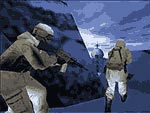 In 1998, Red Storm came out with a quirky little title
that took the gaming world by surprise. Based upon a Tom Clancy novel, Rainbow Six
featured a storyline that had you leading an elite NATO anti-terrorist squad against
insidious troublemakers from around the globe. The kicker was that the game combined this
realistic strategic setting with a first-person shooter perspective. Up until then,
FPS’s had been considered the guilty pleasures of the gaming world. For all the
charms of Doom, Quake II, and Duke Nukem, they didn’t overtax anyone’s brain.
All that changed with Rainbow Six. Suddenly planning became as important—even more
important--as shooting, and no longer could your character take a clip in the chest and
continue to smash mouth. Nope, in Rainbow Six stealth was all; one false move or one
unconsidered dash through a doorway inevitably lead to one well-placed terrorist’s
bullet, and that was all it took to turn out your lights. Your arsenal didn’t allow
you access to plasma rifles or BFG’s; you had to make do with HK’s, flashbangs,
breaching charges and smoke grenades. And not only did Rainbow Six have a tense single
player game; it became one of the most popular multiplayer games out there as well. For
example, I just checked on the Microsoft Gaming Zone, and the most- played game
was—that’s right—Rainbow Six.
In 1998, Red Storm came out with a quirky little title
that took the gaming world by surprise. Based upon a Tom Clancy novel, Rainbow Six
featured a storyline that had you leading an elite NATO anti-terrorist squad against
insidious troublemakers from around the globe. The kicker was that the game combined this
realistic strategic setting with a first-person shooter perspective. Up until then,
FPS’s had been considered the guilty pleasures of the gaming world. For all the
charms of Doom, Quake II, and Duke Nukem, they didn’t overtax anyone’s brain.
All that changed with Rainbow Six. Suddenly planning became as important—even more
important--as shooting, and no longer could your character take a clip in the chest and
continue to smash mouth. Nope, in Rainbow Six stealth was all; one false move or one
unconsidered dash through a doorway inevitably lead to one well-placed terrorist’s
bullet, and that was all it took to turn out your lights. Your arsenal didn’t allow
you access to plasma rifles or BFG’s; you had to make do with HK’s, flashbangs,
breaching charges and smoke grenades. And not only did Rainbow Six have a tense single
player game; it became one of the most popular multiplayer games out there as well. For
example, I just checked on the Microsoft Gaming Zone, and the most- played game
was—that’s right—Rainbow Six. 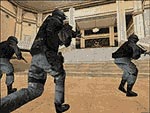 Rogue Spear builds on the phenomenal
success of Rainbow Six. It offers some nice improvements and some handy features, but
don’t expect any revolutionary changes. Like the first game, Rogue Spear finds you
leading your collection of commandos against various and sundry terrorist groups. The
eighteen-mission campaign begins with a series of seemingly unrelated missions spread
across the world. Soon enough, however, you begin to realize that there’s someone
behind all these incidents, and that person is bent upon—cue the music—world
domination. Your job—shut ‘em down.
Rogue Spear builds on the phenomenal
success of Rainbow Six. It offers some nice improvements and some handy features, but
don’t expect any revolutionary changes. Like the first game, Rogue Spear finds you
leading your collection of commandos against various and sundry terrorist groups. The
eighteen-mission campaign begins with a series of seemingly unrelated missions spread
across the world. Soon enough, however, you begin to realize that there’s someone
behind all these incidents, and that person is bent upon—cue the music—world
domination. Your job—shut ‘em down.
Rogue Spear’s graphics are a noticeable improvement over Rainbow Six’s. While
the graphics engine is still not quite state of the art—nobody’s going to
mistake it for Unreal or Half-Life—it does an excellent job of rendering very
atmospheric environments. For example, early on in the campaign you’ll play a
hellaciously tough mission in Kosovo. The mission weaves you through narrow bombed-out
streets during a rainstorm, and it’s eerily realistic. The same goes for all the
other missions, from those conducted on a 747 to those that take place above the Arctic
Circle. Characters look a lot nicer, too; Red Storm has included some nice motion-captured
character animation, and your team’s movements look very realistic; they’ll even
limp if they’ve been clipped in the leg. Speaking of getting clipped, the
tangos’ death throes are terrific. OK, they can be almost comic at times, but they
look damn nice.
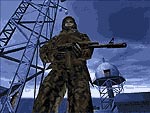 Gameplay also remains much the same. You still get your assignment, choose your
operatives, arm them with a very extensive collection of very nasty weapons, and then
design a plan. But a few new features make a big difference.
Gameplay also remains much the same. You still get your assignment, choose your
operatives, arm them with a very extensive collection of very nasty weapons, and then
design a plan. But a few new features make a big difference.
For example, now some of your operatives can specialize in sniping. In a couple of the
missions, this is a big advantage. The planning phase has been improved with the addition
of several new actions—now your commandos can be told to cover and defend. Once you
enter the action phase, you’ll notice other welcome additions. First, you can now
crouch and move—or run. It’s a tremendous help, especially in the campaign
game’s recon missions, in which you’ve got to move past windows and make the
most of what little cover you can scrounge. You can also peek around doorways now. Again,
this is very helpful, and can often be done without tangos spotting you.
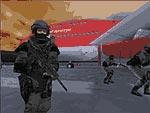 And the enemy artificial intelligence has been buffed way up. In Rainbow Six, most
enemy tangos were pitifully dense. You could snipe at a terrorist while his buddies
standing next to him did nothing but—well, continue standing next to his now-dead
body. Cold-hearted bastards, those terrorists. And suicidal, too. In Rogue Spear, however,
terrorists are much, much, brighter. Sure, they’ll still make a stupid move or two,
but they’re alert little devils. In fact, tangos are terribly quick to respond, and
they’re also very quick and deadly shots.
And the enemy artificial intelligence has been buffed way up. In Rainbow Six, most
enemy tangos were pitifully dense. You could snipe at a terrorist while his buddies
standing next to him did nothing but—well, continue standing next to his now-dead
body. Cold-hearted bastards, those terrorists. And suicidal, too. In Rogue Spear, however,
terrorists are much, much, brighter. Sure, they’ll still make a stupid move or two,
but they’re alert little devils. In fact, tangos are terribly quick to respond, and
they’re also very quick and deadly shots.
And as before, multiplayer is a kick. Rainbow Six’s multiplayer aspect was cranked
way up in the Eagle Watch add-on, and Rogue Spear’s multiplayer ups the ante.
It’s chock full of game options, it’s elegantly implemented, and it rewards
smart team play and solid tactics. If you’ve got the connection for it, this is bar
none the most thoughtful and rewarding multiplayer FPS out there.
 But the game has its glitches, too. For all the graphic improvement, there are still
clipping problems, and you don’t need a heartbeat monitor to tell you a tango’s
in the next room when his weapon’s sticking through a wall. And for all the
improvement of enemy AI, it doesn’t seem like much has been done to improve your
team’s intelligence—in fact, one of the most frustrating things about Rogue
Spear is the trouble your teams will get into when you’re not riding herd on them.
Since terrorists are plenty sharper than before, it’s not unusual for you to be
leading Red Team stealthily towards victory, only listen helplessly while Blue Team
botches the whole thing. The only option is to switch teams constantly, only leaving teams
uncontrolled when they’re safely tucked away from trouble. This surprising
incompetence in soldiers who are reputedly "the best of the best" can make
missions very difficult.
But the game has its glitches, too. For all the graphic improvement, there are still
clipping problems, and you don’t need a heartbeat monitor to tell you a tango’s
in the next room when his weapon’s sticking through a wall. And for all the
improvement of enemy AI, it doesn’t seem like much has been done to improve your
team’s intelligence—in fact, one of the most frustrating things about Rogue
Spear is the trouble your teams will get into when you’re not riding herd on them.
Since terrorists are plenty sharper than before, it’s not unusual for you to be
leading Red Team stealthily towards victory, only listen helplessly while Blue Team
botches the whole thing. The only option is to switch teams constantly, only leaving teams
uncontrolled when they’re safely tucked away from trouble. This surprising
incompetence in soldiers who are reputedly "the best of the best" can make
missions very difficult.
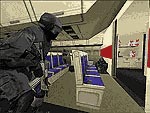 Which leads me to another quibble with Rogue Spear. As in Rainbow Six, you can only
control your team’s leader. You can’t switch to control team members who might
be carrying essential equipment—in order to make them conduct a non-planned action,
you have to kick out to orders mode. It’s a bit clumsy, and something that I hoped
would be addressed in this game. But it’s not. This is made more problematic by the
planning map, which hasn’t changed much from Rainbow Six and which is awkwardly
implemented during gameplay. For example, if during the heat of the mission you skip one
of your planned waypoints or don’t call a planned go code, your map will quickly
become an entangled mess of lines and points. The only way to undo the maze is to
backtrack. Not something, I imagine, that most anti-terrorist teams do with any frequency.
Which leads me to another quibble with Rogue Spear. As in Rainbow Six, you can only
control your team’s leader. You can’t switch to control team members who might
be carrying essential equipment—in order to make them conduct a non-planned action,
you have to kick out to orders mode. It’s a bit clumsy, and something that I hoped
would be addressed in this game. But it’s not. This is made more problematic by the
planning map, which hasn’t changed much from Rainbow Six and which is awkwardly
implemented during gameplay. For example, if during the heat of the mission you skip one
of your planned waypoints or don’t call a planned go code, your map will quickly
become an entangled mess of lines and points. The only way to undo the maze is to
backtrack. Not something, I imagine, that most anti-terrorist teams do with any frequency.
Finally, while multiplayer is great, you better have a blazingly fast internet
connection to enjoy it. You can try to play with a 56.6 modem, but you’ll experience
significant lag and get kicked from a lot of games. Like Quake III, Rogue Spear
multiplayer is for those with bandwidth to burn.
So what’s the final call on Rogue Spear? Well, it improves on Rainbow Six, enough
for me to recommend it, but it still has enough annoying little glitches to keep it out of
five-star territory. Here’s hoping that the next add-on patches Rogue Spear to the
next level.

 In 1998, Red Storm came out with a quirky little title
that took the gaming world by surprise. Based upon a Tom Clancy novel, Rainbow Six
featured a storyline that had you leading an elite NATO anti-terrorist squad against
insidious troublemakers from around the globe. The kicker was that the game combined this
realistic strategic setting with a first-person shooter perspective. Up until then,
FPS’s had been considered the guilty pleasures of the gaming world. For all the
charms of Doom, Quake II, and Duke Nukem, they didn’t overtax anyone’s brain.
All that changed with Rainbow Six. Suddenly planning became as important—even more
important--as shooting, and no longer could your character take a clip in the chest and
continue to smash mouth. Nope, in Rainbow Six stealth was all; one false move or one
unconsidered dash through a doorway inevitably lead to one well-placed terrorist’s
bullet, and that was all it took to turn out your lights. Your arsenal didn’t allow
you access to plasma rifles or BFG’s; you had to make do with HK’s, flashbangs,
breaching charges and smoke grenades. And not only did Rainbow Six have a tense single
player game; it became one of the most popular multiplayer games out there as well. For
example, I just checked on the Microsoft Gaming Zone, and the most- played game
was—that’s right—Rainbow Six.
In 1998, Red Storm came out with a quirky little title
that took the gaming world by surprise. Based upon a Tom Clancy novel, Rainbow Six
featured a storyline that had you leading an elite NATO anti-terrorist squad against
insidious troublemakers from around the globe. The kicker was that the game combined this
realistic strategic setting with a first-person shooter perspective. Up until then,
FPS’s had been considered the guilty pleasures of the gaming world. For all the
charms of Doom, Quake II, and Duke Nukem, they didn’t overtax anyone’s brain.
All that changed with Rainbow Six. Suddenly planning became as important—even more
important--as shooting, and no longer could your character take a clip in the chest and
continue to smash mouth. Nope, in Rainbow Six stealth was all; one false move or one
unconsidered dash through a doorway inevitably lead to one well-placed terrorist’s
bullet, and that was all it took to turn out your lights. Your arsenal didn’t allow
you access to plasma rifles or BFG’s; you had to make do with HK’s, flashbangs,
breaching charges and smoke grenades. And not only did Rainbow Six have a tense single
player game; it became one of the most popular multiplayer games out there as well. For
example, I just checked on the Microsoft Gaming Zone, and the most- played game
was—that’s right—Rainbow Six.